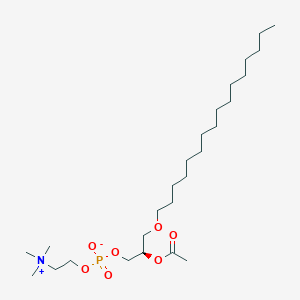| General Information of MET (ID: META00939) |
| Name |
Platelet-activating factor
|
| Synonyms |
Click to Show/Hide Synonyms of This Metabolite
(R)-7-(Acetyloxy)-4-hydroxy-N,N,N-trimethyl-3,5,9-trioxa-4-phosphapentacosan-1-aminium hydroxide inner salt 4-oxide; 1 Alkyl 2 acetyl sn glycerophosphocholine; 1-Alkyl-2-acetyl-sn-glycerophosphocholine; 1-Hexadecyl-2-acetyl-GPC; 1-Hexadecyl-2-acetyl-glycero-3-phosphocholine; 1-Hexadecyl-2-acetyl-glycerophosphocholine; 1-Hexadecyl-2-acetyl-sn-glycero-3-phosphocholine; 1-Hexadecyl-2-acetyl-sn-glycero-phosphatidylcholine; 1-O-Hexadecyl paf; 1-O-Hexadecyl-2-O-acetyl-sn-glycero-3-phosophocholine; 1-O-Hexadecyl-2-O-acetyl-sn-glycero-3-phosphocholine; 1-O-Hexadecyl-2-O-acetyl-sn-glyceryl-3-phosphorylcholine; 1-O-Hexadecyl-2-acetyl-sn-glycero-3-phosphocholine; 1-O-Hexadecyl-2-acetyl-sn-glycerophosphocholine; 1-O-Hexadecyl-2-acetyl-sn-glyceryl-3-phosphorylcholine; 1-O-Hexadecyl-platelet-activating factor; AGEPC; APRL; Acetyl glyceryl ether phosphorylcholine; Acetyl-glyceryl-ether-phosphorylcholine; Aggregating factor, platelet; Antihypertensive polar renomedullary lipid; Blood platelet-activating factor; Blood platelet-activating factor acether; C16 PAF; C16-PAF; C16-PAF acether; C16:0 PAF; Factor, platelet activating; GPC(16:0/2:0); GPC(18:0); GPC(O-16:0/2:0); GPCho(16:0/2:0); GPCho(18:0); GPCho(O-16:0/2:0); HAG-PC; HAGPC; HD-PAF; Hexadecyl-paf-acether; PAF; PAF 16; PAF C 16; PAF acether; PAF-16 CPD; PAF-acether; PC(16:0/2:0); PC(18:0); PC(O-16:0/2:0); Phosphatidylcholine(16:0/2:0); Phosphatidylcholine(18:0); Phosphatidylcholine(O-16:0/2:0); Phosphorylcholine, acetyl glyceryl ether; Platelet activating factor; Platelet activating substance; Platelet aggregating factor; Platelet aggregation enhancing factor; Platelet-activating factor; Platelet-activating factor (1-O-hexadecyl); Platelet-activating factor C16; Platelet-activating factor acether; Platelet-activating substance; Thrombocyte aggregating activity
|
| Source |
Aliphatic acyclic compounds
|
| Structure Type |
Glycerophosphocholines (Click to Show/Hide the Complete Structure Type Hierarchy)
Lipids and lipid-like molecules
Glycerophospholipids
Glycerophosphocholines
|
| PubChem CID |
|
| HMDB ID |
|
| Formula |
C26H54NO7P
|
| Structure |
<iframe style="width: 300px; height: 300px;" frameborder="0" src="https://embed.molview.org/v1/?mode=balls&cid=108156"></iframe>
|
 |
|
3D MOL is unavailable
|
2D MOL
|
|
Click to Show/Hide the Molecular/Functional Data (External Links/Property/Function) of This Metabolite
|
| DrugBank ID |
|
| ChEBI ID |
|
| ChemSpider ID |
|
| Physicochemical Properties |
Molecular Weight |
523.7 |
Topological Polar Surface Area |
94.1 |
| XlogP |
6.5 |
Complexity |
546 |
| Heavy Atom Count |
35 |
Rotatable Bond Count |
26 |
| Hydrogen Bond Donor Count |
N.A. |
Hydrogen Bond Acceptor Count |
7 |
| Function |
Platelet-activating factor, also known as PAF and PC(O-16:0/2:0), is a ubiquitous, potent phospholipid activator and mediator of inflammation that has an important role in the pathogenesis of inflammatory disorders and cardiovascular disease. PAF is able to cause platelet aggregation and anaphylaxis. PAF is synthesized continuously in low quantities in many different types of cells, but especially those involved in host defence, such as macrophages, monocytes, granulocytes, neutrophils, platelets, and endothelial cells. Platelet-activating factor receptor (PAFR) is a G-protein coupled receptor (GPCR) located on the cell membranes of a variety of cells. Once bound to its receptor, PAF mobilizes calcium and activates a wide range of signalling pathways (e.g. phospholipase C-mediated signalling.
|
|
Regulatory Network
|
|
|
|
|
|
|
|
|
 click to show the details of this protein
click to show the details of this protein
 click to show the details of experiment for validating this pair
click to show the details of experiment for validating this pair

